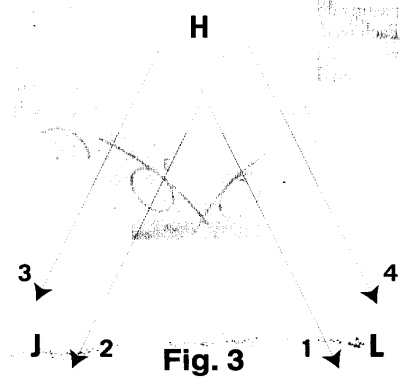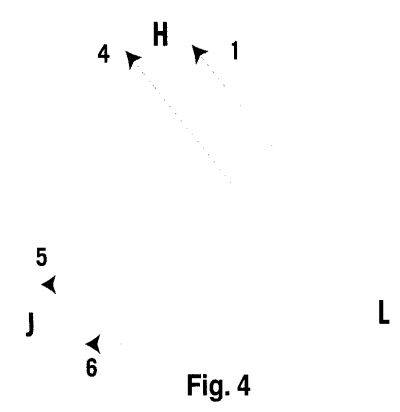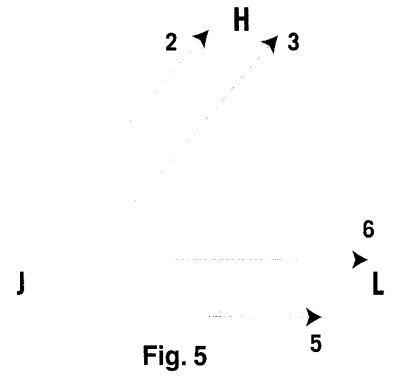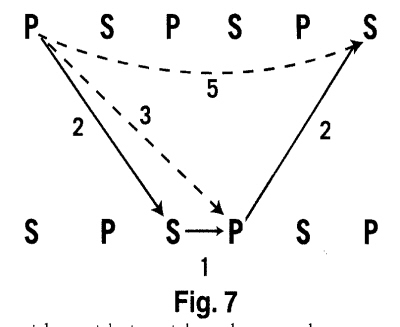|
From the Winter 1993/1994 Workshop comes this explanation of the real Hovey's Nightmare, as learned by me from Hovey Burgess. A few issues before I wrote this, I had described a somewhat similar pattern that I had mistakenly thought was Hovey's Nightmare.
Hovey's Original Nightmare How is Hovey's own Nightmare different from the one I've explained before in this column? In his version, each of the three people does something different, whereas in my published version (as in Dingman's) all three people do the same thing, but out of phase. As a result, if you learn one corner in my version, you can do the other two easily (only the start is different). But for Hovey's version, you have three different roles to learn.
In both versions, whenever you pass to someone, that person is also passing to you. (There are no triangle passes in which all three people pass at once.) On each count, two people are exchanging clubs while the other person does a self. If you remember this fact and the sequence of passes for any person in the nightmare, then you can reproduce the entire pattern.
The first role (Hovey's own) in his pattern has four consecutive passes - inside, inside, outside, outside (RLRL) - and then two selves (RL) (see Fig. 3).
The second role (originally Larry Pisoni's) also has four consecutive passes, but it starts with only one pass (R - outside) and then two selves (LR). From there on, it alternates four passes - inside, inside, outside, outside (LRLR) - and two selves (LR) (see Fig. 4). This role is actually the mirror image of the first role, except for starting at a different place in the sequence; in one the consecutive passes are RL and in the other they are LR.
The third role (originally Judy Finelli's) is distinctly different from the first two since there are never four passes in a row. The third person has a self (R) followed by two passes - outside, inside (LR). Then another self (L) and two more passes - outside, inside (RL) (see Fig. 5). Each pair of consecutive passes is thrown to one person; the first pair goes to the person on the left ("Hovey") and the second pair goes to the person on the right ("Larry"). Note that the first three throws and the second three are mirror images of each other.
Hovey says that he and his partners never got further than about twice through the pattern back in the 1970s. With the aid of modern clubs and modern left-handed passing experiences, Hovey, Laurie Epstein and I managed to get through three repetitions of the cycle at Leeds after Hovey had taught it to us.
In the Summer 1994 issue, I revealed my pattern drawing scheme that I'd been using for several years called causal diagrams. They're great for working out passing patterns, but here I explain how to figure out all the possible doubles, triples, etc., that you can sneak into a pattern without disturbing the rhythm.
Causal Diagrams Here's an important feature of causal diagrams. Any regular pattern of O objects and H hands will have O-H causal lines flowing through the whole diagram. This O-H is the number of objects that cannot be held in the hands if each hand is limited to one object. So O-H is just the number of objects normally in the air (ignoring what happens during the brief periods of the exchanges).
Possible Site Swaps from a Causal Line You can find all the possible special throws for a given hand and moment by just looking ahead at the causal line that goes through that hand at that moment. You can omit two or more consecutive throws in a causal line and replace them with a throw from the beginning to the end of that segment. The number of spins of the special throw is the sum of the spins of the throws in that segment.
Fig. 6 shows the causal diagram for passing seven doubles right handed (a 7club 2-count). Fig. 7 shows one causal line from Fig. 6 so that we can easily see the possible special throws that the first juggler could make instead of the normal initial double. We've labeled each arrow with the number of spins which the particular throw involves (the selves are singles and the passes are doubles). The two dotted lines show potential special throws which bypass one or more hands along the causal line. Each dotted line is labeled with the number of spins that it would need, which you see is the sum of the spins in the normal route along the causal line. For instance, a late right-to-right is a triple, and you can throw a quint right-to-left self (but be careful).
If you have any comments or suggestions for Juggler's Workshop, write to: Juggler's Workshop, Palo Alto, CA. |




